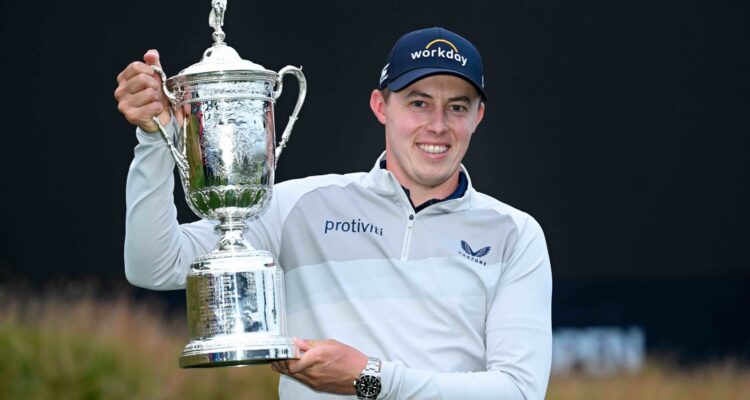After winning the US Open in dramatic fashion, Matt Fitzpatrick has finally arrived at golf’s top table, but true to his Yorkshire roots, he’s doing it while keeping his feet firmly on the ground
Exclusive interview by Nick Bayly
A major champion, a first victory in the US, and now ranked inside the world’s top 10. How good does life feel right now?
Winning a major title is a dream come true for me. It’s something I’ve worked very hard for for a very long time, and it feels like I’ve been rewarded for all that hard work and patience. I feel like I can retire a happy man.
Looking back, it was always going to be a leap into the unknown when I turned professional after leaving college nine years ago, so to be where I am, and having achieved what I have so far, makes me very proud. Although there is obviously a lot more I want to do in the game in the years ahead, I’m pretty pleased with where I am right now.
Having won the US Amateur at Brookline there was a lot of extra focus on you at the US Open. Did you feel that extra pressure, and do you feel like you put extra pressure on yourself in the Majors anyway?
I do put extra pressure on myself in the big events, it’s only natural, but as each one has come along I feel like I’ve got better at handling them, and that showed at the US Open. I felt very comfortable on the course, and felt like I knew where to hit it and where not to miss it.
The people around me say that I’m different in a major week and while I can’t see it myself it’s something that I knew I needed to work on. I feel that I’m a different player now to how I was in the early part of my career, so hopefully I can relax more in the Majors and it will start to show. With that first one [Major title] in the bag, I feel like a can win a few more of these. I’m targeting six. It might sound greedy, but I really think it’s an achievable goal.
You also went out in the last group on Sunday at the PGA Championship, with every chance of winning, but ultimately finished fifth. What was take on that week and how did it set you up for what you were able to achieve at the US Open?
The PGA was a pretty good week for me, regardless of the result. To have that experience, going out in the last group on Sunday in a major championship, was a first for me. I was obviously disappointed not to have got it done, but I learned a lot about myself that week and I was definitely able to draw on that experience when I got into the same group at the US Open. Of course, I didn’t think it would come around quite so quickly, but perhaps that was even more to my advantage to have that experience so fresh in my mind.
The biggest takeaway from the PGA was staying patient. I think Saturday’s third round was one of my best days on a golf course in a long time. I got off to such a poor start, so to be able to battle back and shoot what I did, gave me a lot of satisfaction. That was a big positive despite not coming away with the title. At the end of the day, I didn’t play well enough. I probably had my ‘C’ game on Sunday, not even my ‘B’, and that was never going to good enough.
The US Open required similar, if not more patience, especially with all the wind that we faced. There were so many holes which could bite you, yet there were holes that you could get after. It was defend, attack, defend, attack, and it was about knowing when par was a good score.
A few seasons ago you were complaining that the Majors were in the hands of the big hitters, but you seemed to have transformed yourself into one of those players. How have you achieved that?
I’ve spent a lot of time over the last 18 months to two years working with Mike Walker and my coach and biomechanist Dr Sasho Mackenzie. We did a little bit then, and he gave me this speed stick called The Stack. I’ve been doing that religiously week in and week out. It’s like going to the gym. I’ll be honest, it’s worked wonders for my long game.
I feel like if I’d been leading a major three or four years ago, and I was playing with someone like Will Zalatoris in the final group, I’d be concerned that I’m going to be 20 yards behind him off the tee. But I felt comfortable all day that I was going to be past him. To know that I’d be hitting a club less than him on a lot of approach shots gave me alot of confidence. It certainly gave me a mental boost.
You’ve had ten top-ten finishes in your last 17 starts. What do you feel like has been the key to your consistent play over the last six months?
Statistically speaking, my iron play has been considerably better so far this year than it was last year. I’ve made far fewer mistakes. I feel like I’m getting quite deep into a lot or rounds without having a bogey on the card, so that’s been a positive. My short game is also a lot sharper and when I miss greens I’ve been able to rescue pars, which previously might have been bogeys, so it’s little improvements here and there that are making the difference, nothing dramatic. It hasn’t all come together until now, and the result speaks for itself.
It’s well documented that you pay very close attention to your performance stats. Where does this attention to detail come from?
Yeah, I’ve been doing my own stats for a long time – since I was 14, if you really want to know, so it’s not a new thing for me. But during the first lockdown back in March 2020, I got in touch with Edoardo Molinari, who plays on the European Tour, but has also created his own stats analysis programme that records pretty much anything you want to record.
One element of his programme tracks dispersion, something which I’d not done before, but was very interested in. Say, on your approach to the green you’re aiming four yards right of the flag each time, but you’re pulling it two yards left, there’s a six-yard difference there on your aim. So, while it might look good on your ‘strokes gained approach’ stats, when measured against your actual target you’re still six yards away. Using Edoardo’s programme, I now know what my strokes gained to my target is rather than just strokes gained to the pin. It just made it more specific to my game, seeing my own patterns, and it helps me plot my way around the golf course a bit better.
Over time we’re gradually building up a better picture of my overall game, and although the improvements might be marginal, or sometime barely noticeable, it gives me a better understanding of where my weaknesses – and strengths – lie and what we can work on. It’s certainly helped me structure my practice sessions better, enabling me to focus on the things that need improving rather than spending too much time on things that are already working well.
As a player, you seem like someone who is never quite satisfied, and that you will always pushing to find that bit extra. Is that a fair assessment?
No matter how good your achievements are, I think you can always be striving for more. There will always be guys that are having success and I suppose that competition is what motivates me. With so many players out there playing well week-in and week-out, you can never be content with your own game, no matter how good it is. I really want to be the best golfer I can possibly be, and if I give 100 per cent – there isn’t much more I can ask of myself.
Billy [Foster] once described you as ‘the ultimate professional’ and ‘Bernhard Langer’s love child’. What did he mean by the Langer reference?
It was nice to hear the first part, but I guess what he really means by the Langer bit is that I might be prone to over-analysing things and get overly obsessed with details! I’m very lucky to have Billy. He’s got so much experience, and has been there, done it and got the T-shirt.
How great was it to have Billy on the bag for your major breakthrough and for you to help him to his first major win as a caddie?
I am so pleased for him. He’s had quite a few near misses over the years, so I was just delighted that we were able to get the job done. He was almost more emotional than I was at the end there, but it just showed how much it meant to both of us. He has been just an asset over the last 3-4 years since we started working together, and I’m just so lucky to have someone with that much experience to guide me through these tournaments.
What will being able to call yourself a major champion do you for going forward. Do you feel like the shackles are off?
It’s funny, after Shane [Lowry] won the Open, he told me that he got some abuse at a tournament soon after when he wasn’t playing very well and he said that it didn’t bother him at all, because I knew he’d won a major. And I think I’ll be drawing on that one a lot when things aren’t going my way.
But once you’ve got one, you know you want to go and win more now, there’s no doubt about that. I’ll just keep doing what I’m doing and hopefully more will come.
How much are you looking forward to teeing it up at St Andrews as a major champion?
It will be great. I love playing St Andrews. It’s a great golf course. It’s going to be interesting, obviously, with the length and everything. And now I’m a bomber, I’ll probably be driving most of the greens! Yes, I’m looking forward to it. I’ve got two weeks off now, which I couldn’t be happier about. I’ll get my head around a few things, and then we’ll go to St Andrews.
You seem to have cut back on your schedule over the last two seasons. Is that to help you fresh?
Yes, I have deliberately played fewer events over the last couple of years, and that has really helped to keep me fresh. When Billy came on to my bag, he stressed the need to take more breaks. Looking at my schedule in years gone by, I was playing as many as 32 events, and last year I think played 28 or 29. It doesn’t sound like a big difference, but it is. It’s an extra week or two to work on the game, and it’s an extra week or two of rest. It all adds up over the course of a season, and it certainly made a big difference to my performances.
You’ve recently joined Skechers as a tour ambassador. What attracted you to the brand and what specific performance demands do you have from a golf shoe?
The big thing that attracted me to Skechers is that it is solely a footwear company – that’s all they do and they are renowned for making quality products. Things weren’t quite working out the way I wanted with my previous brand, and after speaking with my trainer we decided to make a switch.
I’ve been wearing and testing Skechers GO GOLF shoes for some time now, and I’m really pleased with the comfort and performance that I’m getting from my Pro 5s out on the golf course. I like the way they look, as they’re perhaps a bit more athletic than previous models, and it’s been any easy transition to make.
The service they offer on tour is first class, and they’re happy for me to work with them, sharing ideas and passing on insights that hopefully can help improve future products and help players at all levels of the game.
Do you switch between spikeless and spiked models depending on course conditions?
No, I purely play in spiked shoes. I slide around too much at impact if I wear spikeless. Nothing against those models, but my foot pressures are all over the place, so they just don’t provide enough stability for me. If I’m practicing at golf courses at home in Florida or back in the UK, I’ll wear SoftSpikes – plastic cleats – as they’re kinder to the greens, but when I’m on tour its metal spikes only. I get through three two or three pairs of golf shoes a month. That might sound like a lot, but the amount we play and walk around the course, shoes can scuff up pretty easily and not look their best, so I guess it’s in both our interests to have fresh pairs ready to go. I mainly wear white shoes, but I’ll mix and match depending on what I’m wearing.



